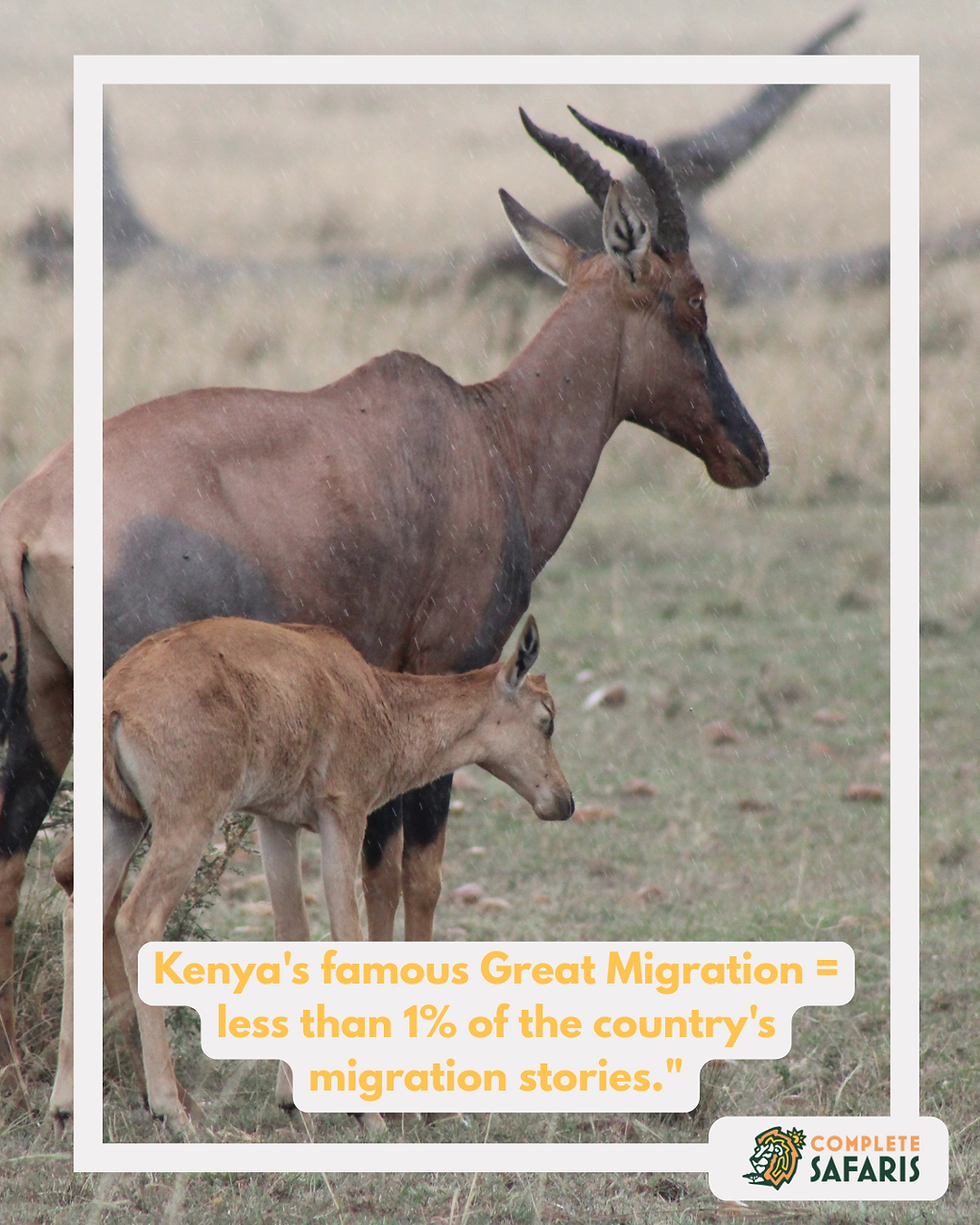The Great Migration Myth: Why July in the Mara Isn't Your Only Option
- Complete Safaris

- Oct 28
- 3 min read

Here's the travel industry's best-kept secret: the famous Great Migration everyone talks about represents less than 1% of Kenya's migration stories. While tourists crowd the Masai Mara in July, paying premium prices to watch wildebeest cross a river, Kenya's most remarkable migrations happen year-round across diverse ecosystems that most visitors never discover.
You've been sold a myth. The real question isn't when to see "the" Great Migration—it's which of Kenya's dozens of migration stories will transform your understanding of this incredible country.
The Wildebeest Marketing Machine
Let's be honest about what's really happening in July at the Mara River. You're watching a spectacular natural event through a crowd of other tourists, paying peak-season prices, fighting for photography positions, and seeing exactly what everyone else sees.
The wildebeest migration is undeniably remarkable. But it's also:
Predictably crowded during peak months
Expensive due to seasonal demand
Limited to specific locations and timing
Overwhelming with tourist vehicles
Weather-dependent and sometimes disappoints
Meanwhile, Kenya's other migration stories offer:
Year-round spectacle across diverse ecosystems
Reasonable pricing outside peak tourism periods
Exclusive experiences away from crowds
Educational depth beyond simple wildlife viewing
Guaranteed activity regardless of seasonal variations
Kenya's Real Migration Calendar
Kenya's "off-season" is a marketing myth created by focus on a single migration event. Every month offers migration spectacle—you just need to know where to look.
January-March: Elephant Family Reunions: While the Mara sits relatively quiet post-wildebeest season, Amboseli hosts elephant family reunions as herds return from Tsavo's dry season dispersal. Watch matriarchs greeting separated relatives and calves meeting extended family for the first time.
April-June: The European Bird Exodus: As wildebeest head south to Tanzania, millions of European birds begin their return migration to summer breeding grounds. Kenya's lakes become staging areas for intercontinental journeys that make wildebeest movements look like neighborhood walks.
July-September: The Secret Elephant Highways: While tourists crowd the Mara, northern Kenya's elephant corridors reach peak activity. The Samburu-Marsabit-Lewa Downs route sees families making strategic decisions about where to spend the dry season.
October-December: Marine Migration Spectacular: As wildebeest prepare for their return north, Kenya's coast hosts whale sharks and nesting sea turtles. Ancient mariners followed ocean currents and magnetic navigation systems that dwarf any terrestrial migration complexity.

The Great Migration Alternative That Never Disappoints
Most visitors arrive with preconceived notions about what they should see and when they should see it. They miss:
Elephant families communicating across vast distances using infrasonic calls that coordinate movements
Bird migration timing that connects Kenya to breeding grounds from Scandinavia to Siberia
Sea turtle navigation precision that brings animals back to birth beaches after decades in open ocean
Community conservation successes that make these migrations possible
Instead of gambling on wildebeest river crossings, consider migration experiences that guarantee remarkable wildlife encounters:
Nairobi National Park's Urban Migration: Year-round wildlife movements with Nairobi's skyline backdrop—an experience that exists nowhere else on Earth.
Amboseli-Tsavo Elephant Highways: Ancient routes where family decisions about survival play out across 8,000 square kilometers of diverse terrain.
Rift Valley Bird Highways: Seasonal concentrations of residents and migrants that create some of the world's most diverse birding experiences.
Coastal Marine Migrations: Ancient sea turtle navigation and whale shark journeys that span ocean basins.

The 365-Day Migration Country and Creating Your Personal Migration Story
While other destinations offer seasonal spectacles, Kenya provides year-round migration stories that connect local ecosystems to global patterns. Most importantly, Kenya's migration diversity means the best time to visit is when YOU can travel, not when marketing materials suggest you should.
Interest-Based Timing: Photography enthusiasts might prefer elephant highway seasons for diverse subjects and optimal lighting.
Family Considerations: Parents might prefer marine migration seasons when coastal experiences complement wildlife viewing.
Adventure Levels: Experienced travelers might seek lesser-known migration routes while newcomers might prefer accessible urban migration experiences.
Ready to discover why Kenya's year-round migrations exceed the famous seasonal spectacle? Let's plan your perfect migration experience, regardless of when you can travel. Email us with a question or two.






